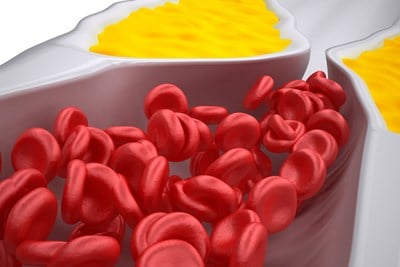The "HDL" in HDL Cholesterol stands for high-density lipoprotein. It's one of the five major groups of lipoproteins (which enable fats to be carried in the bloodstream). Other lipoproteins, in order of largest to smallest, are chylomicrons, VLDL, IDL, and LDL. In healthy individuals, approximately thirty percent of blood cholesterol is carried by HDL. Cholesterol levels are an important measure of heart health.
The Good Cholesterol
Though a physician may say to lower your total cholesterol, it's important to raise HDL cholesterol. High-density lipoprotein cholesterol is known as the "good" cholesterol, so the higher the HDL cholesterol, the better. Lowering LDL (low-density lipoprotein), or the "bad" cholesterol, and raising HDL cholesterol is a great way to reduce your risk of heart disease. If the body has more LDL cholesterol than it needs, the excess keeps circulating in the bloodstream.
The Bad Cholesterol
Over time, circulating LDL cholesterol can enter the blood vessel walls and build up under the vessel lining. Deposits of LDL particles are called plaques, and they narrow the blood vessels. Eventually, they can block blood flow, causing coronary artery disease. HDL cholesterol acts as a scavenger, picking up excess LDL cholesterol and delivering it to the liver, where it's broken down.
High-Density Lipoprotein Cholesterol Symptoms
Even though high cholesterol may lead to serious heart disease, most of the time, there are no symptoms of low HDL cholesterol. This is why it's important to have cholesterol levels checked. The American Heart Association endorses the National Cholesterol Education Program (NCEP) guidelines for the detection of high cholesterol. It is recommended that all adults over the age of 20 should have a fasting lipoprotein profile. This measures total cholesterol, LDL cholesterol, HDL cholesterol, and triglycerides once every five years. This test is done after a nine-to-twelve-hour fast without food, liquids, or pills. The test report will show cholesterol levels in milligrams per deciliter of blood (mg/dL).
To determine how cholesterol levels affect the risk of heart disease, a physician will also consider other risk factors such as age, family history, smoking, and high blood pressure. Even small increases in HDL cholesterol can reduce the frequency of heart attacks. For each 1 mg/dL increase in HDL cholesterol, there is a two-four percent reduction in the risk of coronary heart disease. Although there are no formal guidelines, the proposed treatment goal for patients with low HDL cholesterol is to increase it to above 35 mg/dL for men and 45 mg/dL for women with a family history of coronary heart disease.
High-Density Lipoprotein Cholesterol Treatment
The first step in high-density lipoprotein cholesterol treatment is to modify one's lifestyle. Cardiovascular disease is the number one cause of death in the United States. The good news is that individuals can take control of their cholesterol levels and greatly reduce the risk of heart disease and stroke. As part of a complete prevention and treatment program for managing cholesterol, a doctor may suggest making some lifestyle changes.
Eating a heart-healthy diet is important. This includes a diet rich in vegetables, fruits, whole grains, high-fiber foods, lean meats and poultry, fish at least twice a week, fat-free or one percent dairy products, and foods low in saturated and trans fats, to raise HDL cholesterol and lower LDL.
Enjoy at least thirty minutes of physical activity more days than not, whether it's walking, biking, swimming, jogging, or dancing. Those who smoke tobacco have a much greater risk of high total cholesterol and heart disease and quitting will reduce that risk.
Various medications can lower blood cholesterol levels. They may be prescribed individually or in combination with other drugs. A healthcare professional will determine the best drug or combination, but will most certainly prescribe medications in tandem with appropriate diet and lifestyle modifications to help maintain healthy HDL cholesterol and total cholesterol levels.



